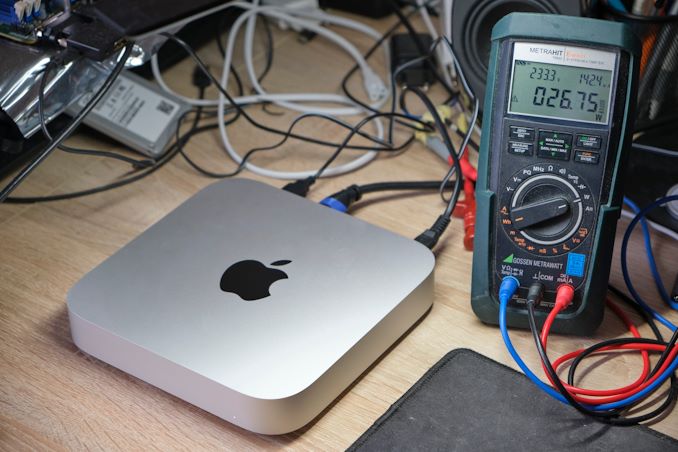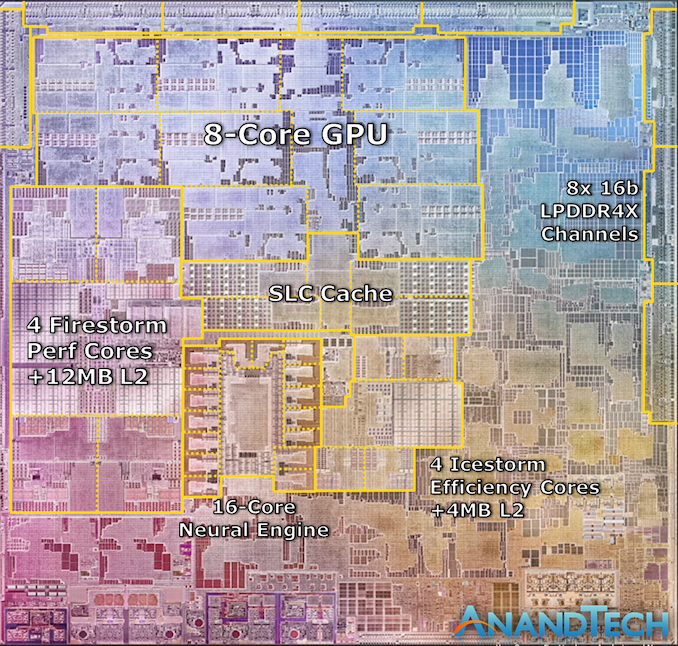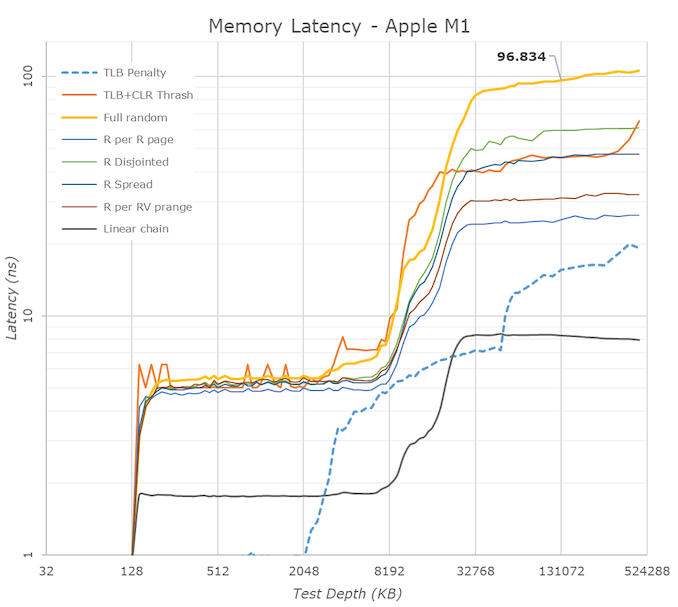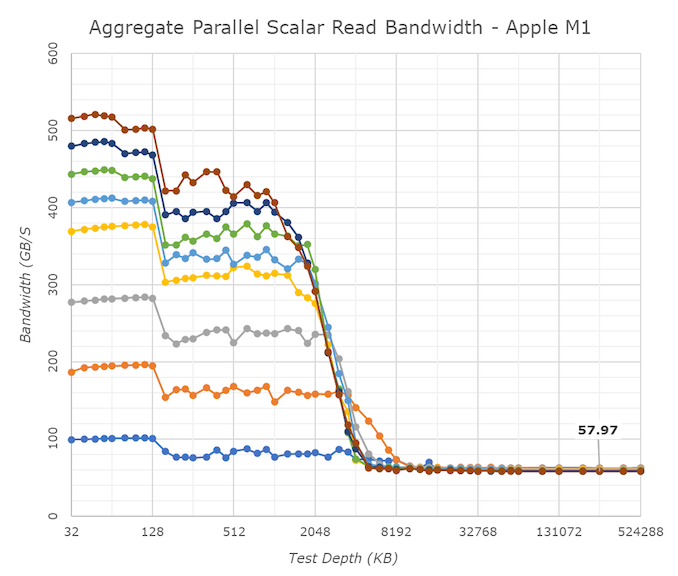The 2020 Mac Mini Unleashed: Putting Apple Silicon M1 To The Test
by Andrei Frumusanu on November 17, 2020 9:00 AM EST
Last week, Apple made industry news by announcing new Mac products based upon the company’s new Apple Silicon M1 SoC chip, marking the first move of a planned 2-year roadmap to transition over from Intel-based x86 CPUs to the company’s own in-house designed microprocessors running on the Arm instruction set.
During the launch we had prepared an extensive article based on the company’s already related Apple A14 chip, found in the new generation iPhone 12 phones. This includes a rather extensive microarchitectural deep-dive into Apple’s new Firestorm cores which power both the A14 as well as the new Apple Silicon M1, I would recommend a read if you haven’t had the opportunity yet:
Since a few days, we’ve been able to get our hands on one of the first Apple Silicon M1 devices: the new Mac mini 2020 edition. While in our analysis article last week we had based our numbers on the A14, this time around we’ve measured the real performance on the actual new higher-power design. We haven’t had much time, but we’ll be bringing you the key datapoints relevant to the new Apple Silicon M1.
Apple Silicon M1: Firestorm cores at 3.2GHz & ~20-24W TDP?
During the launch event, one thing that was in Apple fashion typically missing from the presentation were actual details on the clock frequencies of the design, as well as its TDP which it can sustain at maximum performance.
We can confirm that in single-threaded workloads, Apple’s Firestorm cores now clock in at 3.2GHz, a 6.66% increase over the 3GHz frequency of the Apple A14. As long as there's thermal headroom, this clock also applies to all-core loads, with in addition to 4x 3.2GHz performance cores also seeing 4x Thunder efficiency cores at 2064MHz, also quite a lot higher than 1823MHz on the A14.
Alongside the four performance Firestorm cores, the M1 also includes four Icestorm cores which are aimed for low idle power and increased power efficiency for battery-powered operation. Both the 4 performance cores and 4 efficiency cores can be active in tandem, meaning that this is an 8-core SoC, although performance throughput across all the cores isn’t identical.
The biggest question during the announcement event was the power consumption of these designs. Apple had presented several charts including performance and power axes, however we lacked comparison data as to come to any proper conclusion.
As we had access to the Mac mini rather than a Macbook, it meant that power measurement was rather simple on the device as we can just hook up a meter to the AC input of the device. It’s to be noted with a huge disclaimer that because we are measuring AC wall power here, the power figures aren’t directly comparable to that of battery-powered devices, as the Mac mini’s power supply will incur a efficiency loss greater than that of other mobile SoCs, as well as TDP figures contemporary vendors such as Intel or AMD publish.
It’s especially important to keep in mind that the figure of what we usually recall as TDP in processors is actually only a subset of the figures presented here, as beyond just the SoC we’re also measuring DRAM and voltage regulation overhead, something which is not included in TDP figures nor your typical package power readout on a laptop.

Starting off with an idle Mac mini in its default state while sitting idle when powered on, while connected via HDMI to a 2560p144 monitor, Wi-Fi 6 and a mouse and keyboard, we’re seeing total device power at 4.2W. Given that we’re measuring AC power into the device which can be quite inefficient at low loads, this makes quite a lot of sense and represents an excellent figure.
This idle figure also serves as a baseline for following measurements where we calculate “active power”, meaning our usual methodology of taking total power measured and subtracting the idle power.
During average single-threaded workloads on the 3.2GHz Firestorm cores, such as GCC code compilation, we’re seeing device power go up to 10.5W with active power at around 6.3W. The active power figure is very much in line with what we would expect from a higher-clocked Firestorm core, and is extremely promising for Apple and the M1.
In workloads which are more DRAM heavy and thus incur a larger power penalty on the LPDDR4X-class 128-bit 16GB of DRAM on the Mac mini, we’re seeing active power go up to 10.5W. Already with these figures the new M1 is might impressive and showcases less than a third of the power of a high-end Intel mobile CPU.
In multi-threaded scenarios, power highly depends on the workload. In memory-heavy workloads where the CPU utilisation isn’t as high, we’re seeing 18W active power, going up to around 22W in average workloads, and peaking around 27W in compute heavy workloads. These figures are generally what you’d like to compare to “TDPs” of other platforms, although again to get an apples-to-apples comparison you’d need to further subtract some of the overhead as measured on the Mac mini here – my best guess would be a 20 to 24W range.
Finally, on the part of the GPU, we’re seeing a lower power consumption figure of 17.3W in GFXBench Aztec High. This would contain a larger amount of DRAM power, so the power consumption of Apple’s GPU is definitely extremely low-power, and far less than the peak power that the CPUs can draw.
Memory Differences
Besides the additional cores on the part of the CPUs and GPU, one main performance factor of the M1 that differs from the A14 is the fact that’s it’s running on a 128-bit memory bus rather than the mobile 64-bit bus. Across 8x 16-bit memory channels and at LPDDR4X-4266-class memory, this means the M1 hits a peak of 68.25GB/s memory bandwidth.
In terms of memory latency, we’re seeing a (rather expected) reduction compared to the A14, measuring 96ns at 128MB full random test depth, compared to 102ns on the A14.
Of further note is the 12MB L2 cache of the performance cores, although here it seems that Apple continues to do some partitioning as to how much as single core can use as we’re still seeing some latency uptick after 8MB.
The M1 also contains a large SLC cache which should be accessible by all IP blocks on the chip. We’re not exactly certain, but the test results do behave a lot like on the A14 and thus we assume this is a similar 16MB chunk of cache on the SoC, as some access patterns extend beyond that of the A14, which makes sense given the larger L2.
One aspect we’ve never really had the opportunity to test is exactly how good Apple’s cores are in terms of memory bandwidth. Inside of the M1, the results are ground-breaking: A single Firestorm achieves memory reads up to around 58GB/s, with memory writes coming in at 33-36GB/s. Most importantly, memory copies land in at 60 to 62GB/s depending if you’re using scalar or vector instructions. The fact that a single Firestorm core can almost saturate the memory controllers is astounding and something we’ve never seen in a design before.
Because one core is able to make use of almost the whole memory bandwidth, having multiple cores access things at the same time don’t actually increase the system bandwidth, but actually due to congestion lower the effective achieved aggregate bandwidth. Nevertheless, this 59GB/s peak bandwidth of one core is essentially also the speed at which memory copies happen, no matter the amount of active cores in the system, again, a great feat for Apple.
Beyond the clock speed increase, L2 increase, this memory boost is also very likely to help the M1 differentiate its performance beyond that of the A14, and offer up though competition against the x86 incumbents.
- Page 1: Apple Silicon M1: Recap, Power Consumption
- Page 2: Benchmarks: Whatever Is Available
- Page 3: M1 GPU Performance: Integrated King, Discrete Rival
- Page 4: SPEC2006 & 2017: Industry Standard - ST Performance
- Page 5: SPEC2017 - Multi-Core Performance
- Page 6: Rosetta2: x86-64 Translation Performance
- Page 7: Conclusion & First Impressions













682 Comments
View All Comments
hanskey - Tuesday, November 17, 2020 - link
The performance measured would have exist for Apple to be able to dump Intel, so it makes sense and kudos to the tax-dodgers on the achievement afforded to them by poaching everyone else's engineers with their tax-free $billions.That said, this device is totally irrelevant for me for all the normal reasons the vast majority the computing market also does not choose Apple products - they are a terrible value and don't run my software.
What's on offer here from Apple is simply not good enough to con me into giving up choice, third party hardware and software, the right to repair, a solid upgrade path, and paying a competitive price for all the above. If I'm not mistaken they are still up-charging by multiples $100's for 512GB of storage, which I can get for around $30 in a MicroSD card, or HDD, not to mention I added a 1TB NVMe SSD to my non-Apple laptop for around ~$130!
marrakech - Wednesday, November 18, 2020 - link
apple goes for the people who work on browser and office softwarean part of the market that can be run at 2.1 Ghz 4 core and for 10 seconds at 3 ghz speed
for the profesionals who do 3d work or need 32 gb ram as an minimum this is like giwing u an 6 year old smartphone to work with
Duncan Macdonald - Tuesday, November 17, 2020 - link
Why are the single threaded benchmarks using the Zen 3 chips for comparison but the multithreaded benchmarks are using the Zen 2 chips. This has an unfortunate effect of making the multithreaded performance seem much better than it is.BlackHat - Tuesday, November 17, 2020 - link
There isn't zen 3 mobile yet, and the according to other sources the multi is equal to a R5 3600X.guycoder - Tuesday, November 17, 2020 - link
The comparison with Zen 3 is only for the purpose of demonstrating the single core performance that Apple has achieved against the current architectural leader in the recent AMD Zen 3. Multithreaded comparison is a like for like and what you can expect against a comparable laptop product available today. There are no Zen 3 based laptop processors in the market today only Intel Tiger Lake and AMD Renoir. Comparing M1 against desktop class processors is not a relevant as you might as well compare it against a 64 core Rome.Makste - Wednesday, November 18, 2020 - link
What he says.Except for the epyc rome part
dan82 - Tuesday, November 17, 2020 - link
Awesome review, thank you so much for putting this together!I think the Rosetta2 vs native scores % in the end are particularly interesting. This made me wonder: How does this compare to Microsoft's x86 emulator in Windows? The Surface Pro X doesn't perform particularly well and I'd be curious to know how much of that is the weaker chip (it seems that the m1 is about 2.2x as fast as the SQ1 on the cpu side) vs how much is due to emulation.
Maybe we could have a deep-dive emulator Rosetta2 vs Microsoft's emulator comparison? :-)
KoolAidMan1 - Tuesday, November 17, 2020 - link
The level of salt and cope in these comments is something else.People should be excited for this, not mad. This is a staggering level of performance compared to what Intel and AMD are delivering. Even if you have no intention of ever buying a Mac you should be glad that this will spur competition from other companies, whether it is from AMD or Nvidia perhaps (maybe Jensen will finally commit to entering the CPU game after the ARM acquisition).
I've lost all hope that Intel does anything worth a damn again, but we'll see, more unlikely comebacks have happened.
Makste - Wednesday, November 18, 2020 - link
Agreed.I'm expecting apple and its M1 derivatives to be looking at AMD competition and for the most exciting part, AMD to be comparing its performance to apple silicon 😁. It is such a pleasant surprise for AMD and its customers because nosooner had AMD defeated Intel, than apple showed up with M1 at equal or even better performance (coz let's face it ryzen 3 based laptops will not be at the same performance level with their desktop counterparts due to power limits). But this means overall, that AMD cannot relax, and if it (AMD's ryzen, newer or
older architecture) can keep up with this new architecture, it'll take it well ahead. By the power vested in me as a customer, I give this new competition between AMD and Apple my blessing 😌
BushLin - Wednesday, November 18, 2020 - link
The only thing that's mad is fanboys saying the Apple chip is far ahead of anything when all it's done is show impressive single thread performance on a 5nm process Apple paid to have to itself. If those comments didn't exist and need correcting it'd just be enthusiasts congratulating Apple on the wide design and GPU efficiency.